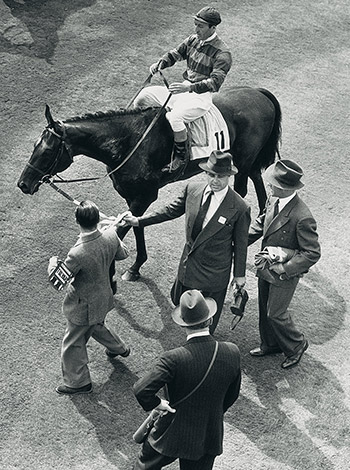
He was as surprised as everyone at the outcome but that did not dampen his enthusiasm at his win. Two years later he had a near miss Triple Crown colt in Dastur who finished 2nd in the 2,000 Guineas and the Derby.
However, His Highness’ most remarkable Classic challenge ever was laid down for the 1932 St. Leger. Four runners carried his colours and they filled four of the first five places with Firdaussi beating Dastur while Udaipur and Taj Kasra finished 4th and 5th respectively, a spread of some five lengths covering the quintet.
Because Dastur was out of Friar’s Daughter - the filly that Mumtaz Mahal had "lost" in that famous home gallop - it would be natural to assume that her progeny could have no higher aspirations than to be placed in Classics. Yet only three years later this mare, who had been a bargain basement 250 guineas yearling, had her name up in lights after her mating with Blandford produced Bahram, an authentic Triple Crown hero. Bahram was indeed the only horse between the two World Wars to win the 2,000 Guineas, Derby and St. Leger in 1935. Frank Butters, who had taken over the Aga Khan’s horses after a falling out with Richard Dawson, said Bahram was the best he had ever trained. He added, though, that because Bahram "was very lazy and had never been beaten, not even I knew how good he was."
The punters had correctly worked out this Derby with Bahram (Freddie Fox) who was favourite but the following year, it was again "the wrong one" that triumphed as Mahmoud (Charlie Smirke) at odds of 100 to 8 got first run on his 6 to 1 stablemate Taj Akbar, the mount of Gordon Richards, and won by two lengths. On this very fast ground there were two records set. Mahmoud’s time of 2 minutes 33.8 seconds is the fastest hand-held timing ever clocked while the late Aga Khan remained the only owner in 150 years to have had his colours carried first and second in the Derby, up until 1995.
During the war years financial necessity was behind the Aga Khan’s decision to sell his Derby winners rather than aspire to embellish his record. In 1940 he parted with Bahram and Mahmoud for a total of £60,000, a fraction of their value on an open market. Blenheim had preceded them to the United States where he became champion sire in 1941. Mahmoud, whose progeny were better suited to American conditions than those got by Bahram, was champion in 1946 and the leading broodmare sire in 1957.
When peace returned the Aga Khan began buying again. His son Prince Aly Khan, who, like the present Aga Khan was a superbly good race reader, had espied Epsom potential in My Love after his Prix Hocquart success. A half-share was acquired from Leon Volterra for £15,000 with the colt running in the name and colours of his new part-owner. With a romantic name like My Love he was an assured public fancy. Rae Johnstone, still decried for losing a prewar Derby on hot favourite Colombo, put matters right this time with a stylish ride.
A still more popular Derby winner in these colours was Tulyar in 1952. His renown was due in large measure to a cheeky telegram from jockey Charlie Smirke to the Press Club Derby Luncheon: "Hope on Wednesday at 3:40, I will be saying ’what did I Tulyar."
The bookmakers did not share Smirke’s enthusiasm for his chances and were still laying odds of 100 to 8 when betting on the course began. However, a wholesale public gamble took place and Tulyar went to post the 11 to 2 favourite and got home by three quarters of a length from Gay Time, ridden by a teenager named Lester Piggott.
When the Aga Khan decided to sell Tulyar, he accepted a lesser bid for him from the Irish National Stud and turned down a much higher offer made by the American breeder, Mrs. Whitney Tippett. This successfully stilled much of the controversy over his sale of previous Derby winners to American breeders and owners.